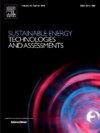An examination of country participation in carbon capture projects
IF 7.1
2区 工程技术
Q1 ENERGY & FUELS
Sustainable Energy Technologies and Assessments
Pub Date : 2025-06-27
DOI:10.1016/j.seta.2025.104418
引用次数: 0
Abstract
Carbon capture, utilisation and storage represents an important technology for countries to address climate change challenges, achieve decarbonisation and reach net zero targets. This study examines the factors that are association with country level participation in carbon capture projects. A Poisson regression model is employed to examine the relationship between country level factors (such as GDP per capita, regional partition, trade openness, economic complexity and tax initiatives) and the number of carbon capture project initiated within a country (from 2019 up until February 2023). We find that a country’s region (as defined by the World Bank), market affluence and level of CO2 emissions is associated with a country’s participation in carbon capture projects. The results indicate that nations that are more affluent and have higher CO2 emissions are associated with increase participation in carbon capture projects. Carbon tax and Emissions Trading Systems have a positive impact on a country’s participation in carbon capture projects, in particular carbon tax. This indicates that carbon tax acts as an effective incentive for industry engagement with carbon capture technologies. This study also examines the interplay between economic complexity and country level carbon capture project participation, where a negative relationship is observed.
审查各国参与碳捕获项目的情况
碳捕获、利用和封存是各国应对气候变化挑战、实现脱碳和实现净零目标的重要技术。本研究考察了与国家层面参与碳捕获项目有关的因素。采用泊松回归模型检验了国家层面因素(如人均GDP、区域划分、贸易开放程度、经济复杂性和税收举措)与一个国家内启动的碳捕集项目数量(从2019年到2023年2月)之间的关系。我们发现,一个国家的地区(根据世界银行的定义)、市场富裕程度和二氧化碳排放水平与一个国家参与碳捕集项目有关。研究结果表明,越富裕、二氧化碳排放量越高的国家参与碳捕获项目的程度越高。碳税和排放交易体系对一国参与碳捕集项目,特别是碳税具有积极影响。这表明,碳税可以有效地激励行业参与碳捕获技术。本研究还考察了经济复杂性与国家层面碳捕获项目参与之间的相互作用,其中观察到负相关关系。
本文章由计算机程序翻译,如有差异,请以英文原文为准。
求助全文
约1分钟内获得全文
求助全文
来源期刊

Sustainable Energy Technologies and Assessments
Energy-Renewable Energy, Sustainability and the Environment
CiteScore
12.70
自引率
12.50%
发文量
1091
期刊介绍:
Encouraging a transition to a sustainable energy future is imperative for our world. Technologies that enable this shift in various sectors like transportation, heating, and power systems are of utmost importance. Sustainable Energy Technologies and Assessments welcomes papers focusing on a range of aspects and levels of technological advancements in energy generation and utilization. The aim is to reduce the negative environmental impact associated with energy production and consumption, spanning from laboratory experiments to real-world applications in the commercial sector.
 求助内容:
求助内容: 应助结果提醒方式:
应助结果提醒方式:


